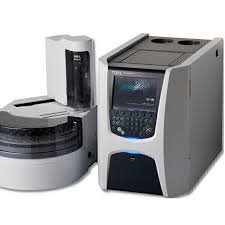Describe the principle behind a TOC analyzer and the steps involved in its calibration.

Principle and Calibration of a TOC (Total Organic Carbon) Analyzer
Principle Behind a TOC Analyzer:
A Total Organic Carbon (TOC) analyzer is used to measure the amount of organic carbon present in a sample, typically water. It does this by detecting carbon atoms that are part of organic molecules, differentiating them from inorganic carbon (e.g., carbonates and bicarbonates).
There are two main steps involved in TOC analysis:
-
Oxidation of Organic Carbon:
-
Organic carbon is converted into carbon dioxide (CO₂) through oxidation.
-
Oxidation can be achieved by:
-
Combustion (High-temperature) – burning the sample at high temperatures (680–1000 °C) in the presence of a catalyst and oxygen.
-
Chemical/UV oxidation – using UV light and oxidizing agents (like persulfate) to break down organic compounds.
-
-
-
Detection of CO₂:
-
The released CO₂ is measured using detectors such as:
-
NDIR (Non-Dispersive Infrared Detector)
-
Conductivity detector (after converting CO₂ to carbonic acid in water)
-
-
The amount of CO₂ detected is directly proportional to the amount of organic carbon in the sample.
Steps Involved in Calibration of a TOC Analyzer:
Calibration ensures accurate and reliable measurements by comparing the analyzer’s readings with known standards.
-
Preparation of Calibration Standards:
-
Use certified TOC standard solutions (e.g., potassium hydrogen phthalate) of known concentration.
-
Prepare a series of standards, typically covering the expected range of sample concentrations.
-
-
System Cleanliness Check:
-
Run a blank (usually ultrapure water) to ensure no contamination in the system.
-
The blank value should be very close to zero.
-
-
Instrument Warm-Up and Stabilization:
-
Turn on the instrument and allow it to reach its stable operating conditions (e.g., temperature, flow rates).
-
-
Running the Calibration Standards:
-
Inject each standard solution into the analyzer.
-
Record the response (e.g., detector signal or area under curve for CO₂).
-
-
Generate Calibration Curve:
-
Plot detector response versus concentration of the standards.
-
The result should be a linear or near-linear calibration curve depending on the method used.
-
-
Validation:
-
Inject a check standard (mid-point of the range) that was not used to create the calibration curve.
-
The result should fall within ±5% (or as specified) of the known value.
-
-
Documentation and Software Entry:
-
Input calibration curve into the instrument software.
-
Save and document all calibration parameters and results for compliance.
-
-
Routine Recalibration:
-
Perform recalibration at scheduled intervals, after maintenance, or when accuracy is questionable.
-
Summary:
The TOC analyzer works by oxidizing organic carbon to CO₂ and measuring it quantitatively. Calibration involves using known standards to ensure the instrument’s readings are accurate and traceable. Proper calibration is essential for regulatory compliance and data reliability.
🎓 Discover one of the best Quality Assurance courses available — click below to explore the course that’s shaping future QA skills.

